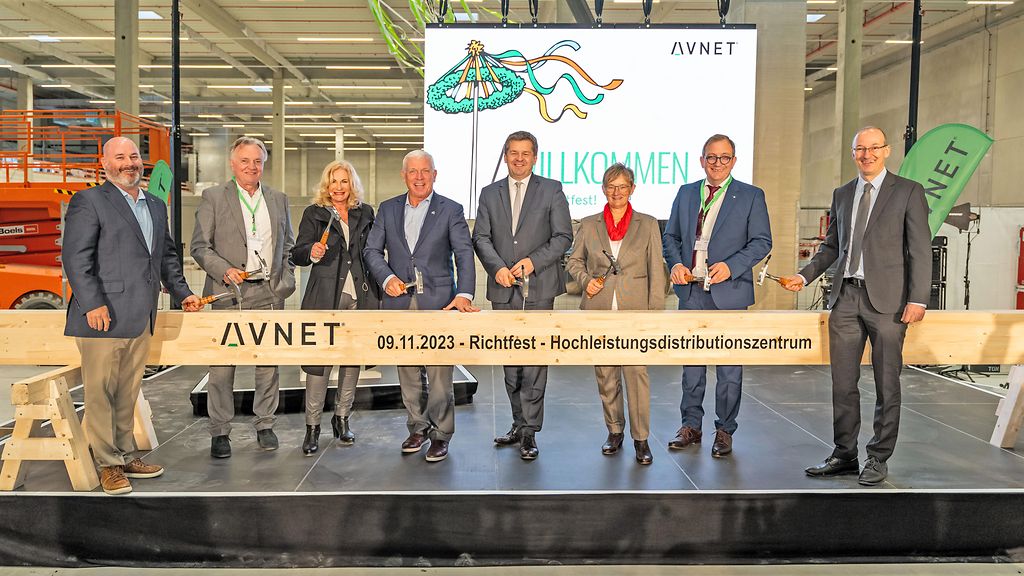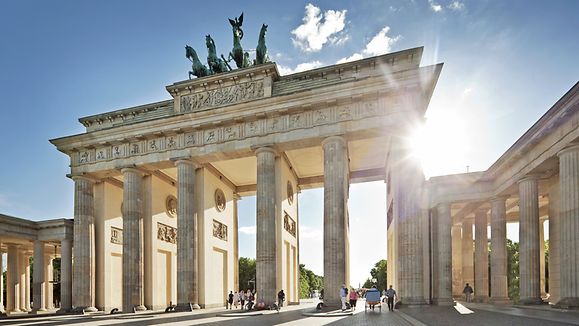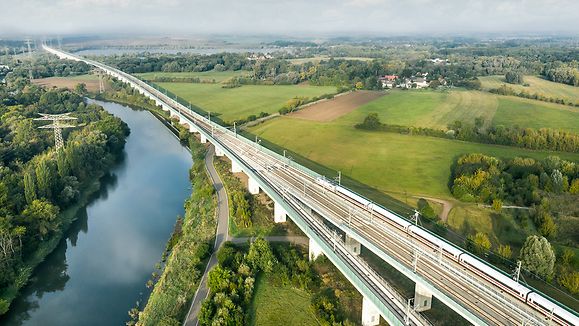Top Investments in 2023 in Saxony-Anhalt
Saxony-Anhalt sees transformation as an opportunity: billions invested in crucial transformation sectors.
Feb 21, 2024
- Semiconductor Companies Attract a Supporting Technological Environment
- Green Hydrogen for Sustainable Transformation
- Renewable Energy Projects and Carbon Capture and Utilization
- Life Sciences in Saxony-Anhalt Takes on a Pioneering Role
- Chemical parks undergo expansion and sustainable transformation
- Innovations in Renewable Energy and Storage Technologies
- Automotive and Logistics: Rapid Development of International Players
- Sustainability Across the Entire Product Lifecycle
- Economic Factor Tourism
- Outlook on the Largest Federal Construction Project of the Decade
Currently, companies are investing almost three billion euros in projects in Saxony-Anhalt that have been approved or initiated since 2022. If we include Intel's giga investments, we need to add another zero. Some of these companies have already started production, while others are set to begin production in 2024.
With regard to the high investment sums, Saxony-Anhalt’s Prime Minister Dr. Reiner Haseloff states, 'We are a rising region.' Whether it's coal phase-out, digitization, or climate change – the restructuring of the economy is a significant challenge but also brings many opportunities. Saxony-Anhalt seizes these opportunities and is developing into a strategically important economic hub. Other major relocation projects, such as Wacker Chemie, Daimler Truck, Avnet, or UPM, demonstrate that despite multiple challenges for the economy, Saxony-Anhalt maintains its status as a modern and sought-after investment location.
The State Administrative Office of Saxony-Anhalt recorded record growth in approval procedures last year. In the field of industrial settlements, the competent authority received 84 applications for the approval of large industrial plants under the Federal Immission Control Act. In 2022, there were only 49.
Semiconductor Companies Attract a Supporting Technological Environment
The largest investment project not only in Saxony-Anhalt but for the entire Germany is Intel's establishment in Magdeburg. Approximately 30 billion euros are to be invested in the construction of multiple chip factories. The US company and the German government reached a financial support agreement in the summer of 2023. Simultaneously, the company initiated collaborations with the six universities in Saxony-Anhalt and is searching for its initial employees. Preparations for the groundbreaking ceremony later this year are underway. Chips are expected to be produced in the two factories no earlier than 2027.
The world's smallest computer chip will soon come from Magdeburg. The US chip manufacturer plans to build chips with a structure size of 1.5 nanometers in its future factory in Magdeburg. This represents the most advanced technology at present. The Magdeburg factory will not only be the most advanced manufacturing facility in Germany but, as announced by Intel CEO Pat Gelsinger at the World Economic Forum in Davos, it will also be the most advanced manufacturing facility in the world to take place in Magdeburg.
In addition to Intel, many other companies in the semiconductor industry are also investing. Sioux Technologies, a globally renowned technology accelerator, is one example. The research and development company, founded in Eindhoven, Netherlands, in 1996, presented its ambitious project and plans for Saxony-Anhalt in 2023. Sioux Technologies, with around 1,100 employees, develops strategic high-tech solutions for various markets, including semiconductors, laboratory and medical technology, mechatronics, imaging, mobility, and clean energy. In Barleben, Sioux plans to invest around 20 million euros in a research and development center, gradually creating three hundred highly qualified permanent jobs. The company has already begun active recruitment, and commissioning is scheduled for the first quarter of 2025.
Leon Giesen, CEO of Sioux Technologies, says, 'We are proud to be among the first to establish ourselves in the Intel technology environment in Saxony-Anhalt. Over the coming years, we will create more than 300 jobs in Barleben. We are grateful for the excellent cooperation with the government, the university, and the technical colleges in this region.'
Meanwhile, in Bernburg, a large high-performance distribution center for semiconductors and electronic components is under construction. The Avnet Electronics Distribution Center celebrated its topping-out ceremony in November 2023. The center, situated on an area of approximately 190,000 square meters, includes multiple logistics halls, as well as adjacent social and administrative buildings, roads, walkways, and parking spaces. By spring 2025, up to 19,000 packages are expected to be delivered daily to over 30,000 customers worldwide. The investment volume exceeds 225 million euros. Over the next eight years, approximately 700 jobs are expected to be created in Bernburg.
The new high-performance distribution center is the third logistics location for Avnet in Europe, alongside Poing (Germany) and Tongeren (Belgium). Phil Gallagher, CEO of Avnet, commented on the investment in the location: 'Europe is one of the most successful regions for Avnet in our global business. Germany is one of our important markets. We are pleased that we can continue to grow at a location that is so important to us in Europe. We thank everyone for the fantastic support on this project, and we hope that we can contribute to the economic location of Bernburg.'
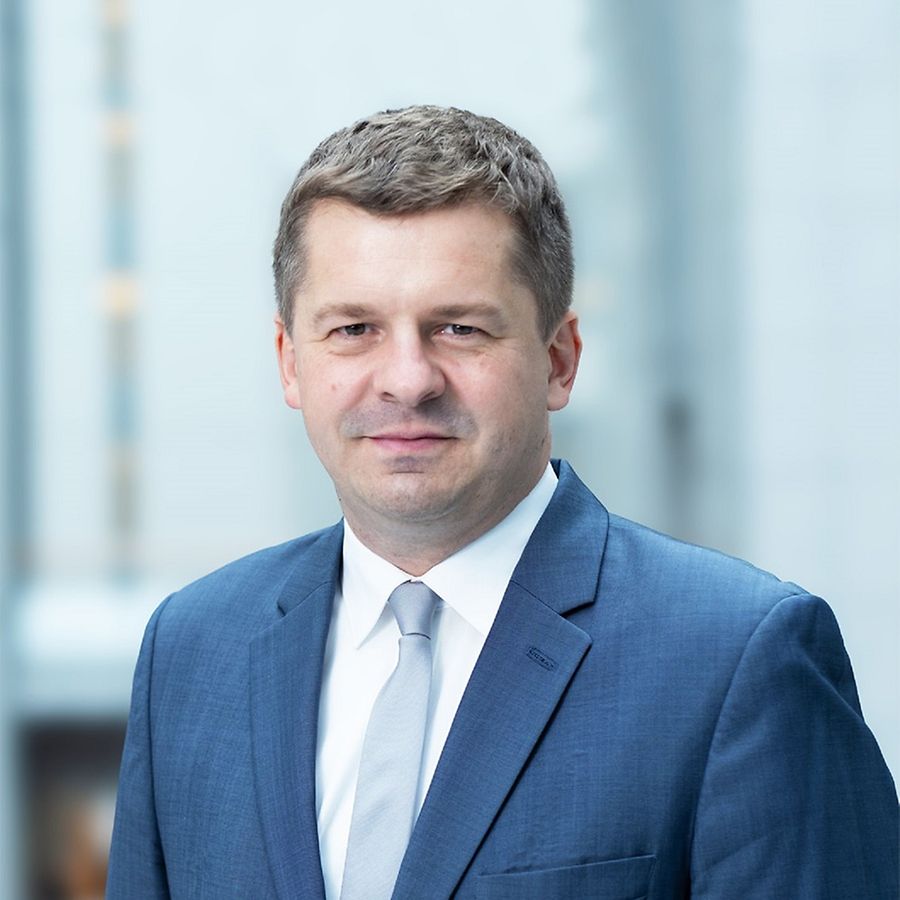
Sven Schulze, Minister for Economic Affairs, Tourism, Agriculture, and Forestry of the state of Saxony-Anhalt, emphasizes the economic dynamism of the region against the backdrop of global challenges: 'Saxony-Anhalt is experiencing significant growth, especially in the areas of semiconductors and electronics. The investments of Sioux Technologies and Avnet are further milestones in the targeted development of our state into a high-tech location. We offer investors the best conditions for establishing themselves in Saxony-Anhalt and participating in our region's success.'
Green Hydrogen for Sustainable Transformation
The demand for hydrogen as a clean energy carrier is increasing globally. Saxony-Anhalt is positioning itself as a pioneer in the production of green hydrogen. In the Anhalt-Bitterfeld district, the companies Yara and Aunexum are investing around 400 million euros in a large electrolysis plant. Starting in 2024, green hydrogen will be produced using wind power. It will be used to produce ammonia at the Yara site in Leuna – another significant investment in the region. Ammonia is an essential raw material for fertilizers and an energy carrier. The production plant in Leuna is expected to be operational by 2026.
Moreover, the Fraunhofer Institute for Microstructure of Materials and Systems IMWS in Halle (Saale) is also involved in the field of hydrogen research. The institute is working on the development of catalysts for efficient water electrolysis. Together with partners from industry and science, Fraunhofer IMWS is conducting research to increase the efficiency of electrolysis processes, thus contributing to the sustainable production of green hydrogen.
Prime Minister Dr. Reiner Haseloff emphasizes the importance of green hydrogen for the energy transition: 'Green hydrogen is a key component for achieving our climate goals. In Saxony-Anhalt, we are consistently investing in the development of this future technology. The projects in the Anhalt-Bitterfeld district and the research at the Fraunhofer Institute in Halle are essential building blocks for a sustainable and climate-friendly energy supply.'
Renewable Energy Projects and Carbon Capture and Utilization
In addition to hydrogen, Saxony-Anhalt is investing in various renewable energy projects. These include wind, solar, and biomass projects. Companies such as Enercon, ABO Wind, and BayWa r.e. are contributing to the expansion of renewable energy capacity in the region.
Furthermore, the region is actively exploring carbon capture and utilization (CCU) technologies. In Leuna, a large-scale CCU project is in planning, which aims to capture and utilize CO2 emissions from industrial processes. The captured CO2 is to be converted into valuable products, contributing to a circular economy and reducing greenhouse gas emissions.
Dr. Reiner Haseloff concludes, 'Saxony-Anhalt is on the path to becoming a model region for sustainable and innovative economic development. The investments in transformation sectors, such as semiconductors, green hydrogen, and renewable energy, underline our commitment to shaping a future-oriented, environmentally friendly, and economically successful state.
Life Sciences in Saxony-Anhalt Takes on a Pioneering Role
The future viability of the federal state is also evident in the field of Life Sciences. The mRNA Center in Halle (Saale) is taking shape as a significant venture. The serious commitment of Wacker Chemie AG to this future technology is underscored by the substantial investment: over 100 million euros are being allocated to the new construction, which is expected to accommodate around 200 employees soon. The development of mRNA technology marked a breakthrough in vaccine development during the COVID-19 pandemic, with both the BioNTech and Moderna vaccines relying on this technology. However, the potential extends far beyond, as researchers have been testing mRNA agents for tumor treatment for several years. At Wacker, there is optimism that within 20 to 30 years, many diseases can be treated with mRNA-based medications.
The Wacker Group aims to establish four production lines in the competence center in Halle. Approximately half of the capacities will be made available to the German government on demand. If commissioned by the government to produce mRNA vaccines, the company asserts that production can commence rapidly. The other half will produce mRNA therapeutics on behalf of customers. For the chemical conglomerate, this new competence center is currently one of the most crucial projects. Ideal location conditions in the heart of Europe favor Saxony-Anhalt, with well-developed infrastructure encompassing modern road, rail, and waterway networks, along with the Halle-Leipzig airport, making it particularly attractive.
Neoscan Solutions recently secured a contract for the world's strongest MRI magnet for human examination. The young medical technology firm in Magdeburg, focusing on the development, manufacturing, distribution, and servicing of innovations, including disruptive innovations in the MRI domain, announced in 2023 the construction of the world's first 14 Tesla MRI magnet based on a fundamentally new magnet technology using high-temperature superconductors. A corresponding flagship project is launched at Radboud University Nijmegen in the Netherlands. In early 2023, a consortium won funding of 19 million euros from the "National Roadmap Large-Scale Research Infrastructure" initiative of the Dutch Research Council (NWO). Neoscan Solutions has thus assumed a pioneering role in the establishment of high-temperature superconductors (HTS). HTS magnets can operate entirely without liquid helium, are more compact, lighter, and can generate and endure much higher magnetic fields without losing their superconducting properties.
Chemical parks undergo expansion and sustainable transformation
The Leuna Chemical Park is set to expand further and stands as one of the largest construction sites in Germany. Over 100 companies from eleven nations are investing 1.3 billion euros in research and green chemistry. The Leuna III project is currently developing an area of around 280 football fields (200 hectares) west of the existing production facilities. The expansion of the chemical park could create up to 250 direct and 750 indirect jobs, predominantly in the field of sustainable chemistry. Dow Chemical, BASF, Shell, and TotalEnergies, among others, produce on-site, and more than 15,000 people work in the chemical park, making it the largest concentration of industrial jobs in a single location in East Germany. With an area of 13 square kilometers, Leuna is already one of the largest chemical parks in Europe.
The Leuna Chemical Park is currently undergoing a transformation, moving away from the use of fossil fuels towards the utilization of sustainable raw materials. Significant progress is being made with the construction of a massive biorefinery by the Finnish company UPM. From wood, plastics are expected to be produced here starting from late 2024. According to UPM, the total cost amounts to nearly 1.2 billion euros. Last year, the first collaborations with companies for the production of plastics were already concluded, including partnerships with outdoor clothing provider Vaude, refrigerant manufacturer Hoertol Chemie, and a distribution partner in Korea. 180 employees have already been hired, and another major customer of the company will be the Coca-Cola company, which plans to produce monoethylene glycol, a key component of PET bottles, in the new refinery. The chemical is to be produced using biomass, with 500,000 tons of beech wood processed annually in the biorefinery.
Chemical and Industrial Park Zeitz (Elsteraue) has seen approximately 400 million euros in investments since 1990. The site, covering around 230 hectares, is now home to 50 production and service companies with a total of 1,000 employees. In comparison to Leuna, Schkopau, and Bitterfeld-Wolfen, this area is considered one of the smaller chemical parks in Germany. The production focuses on chemical raw materials, lubricants, and specialty chemicals. In 2023, approximately 200 million euros were earmarked for investments, creating around 100 new jobs. Among the major projects in Zeitz is a facility by Cropenergies costing about 130 million euros for the production of bio-chemicals. Cropenergies, based in Mannheim (Baden-Württemberg), is a subsidiary of Südzucker AG, which processes sugar beets in a Zeitz facility.
One of the current flagship projects of the Getec Group is the energy facility for the Südzucker subsidiary, with Getec investing 50 million euros. The expanding Puraglobe refinery, where used oils from the mineral oil industry are processed for reuse, such as in motor oils, is also located on the site. Additionally, there is a research project involving the German Biomass Research Center in Leipzig concerning the energetic and material use of biomass. The goal is to use "green natural gas" based on by-products from wheat starch production in the future. This could contribute to replacing, to some extent, the natural gas and electricity purchased for the site from the energy market.
The Chemical Park Bitterfeld-Wolfen is also one of the economic heavyweights in Saxony-Anhalt. The adjacent Technology Park Central Germany gained nationwide recognition through the Solar Valley. The figures for the Bitterfeld-Wolfen Chemical Park are impressive: around 360 companies have settled on approximately 1,000 hectares, employing more than 11,000 workers. Most companies are traditional chemical enterprises, either subsidiaries of international chemical corporations or relatively young firms pushing into the global market. Bitterfeld-Wolfen benefits from a well-developed rail and pipeline network, with the highway not far away.
AMG Lithium, for instance, has chosen the Chemical Park Bitterfeld-Wolfen. The Dutch-American company is investing initially 140 million euros to purify brittle lithium hydroxide and refine it into a battery-grade raw material – a unique undertaking in Europe thus far. The products are supplied to battery manufacturers requiring cathode materials and, consequently, lithium.
Innovations in Renewable Energy and Storage Technologies
Two additional business establishments in Bitterfeld-Wolfen align with the overall trend. The U.S. company NexWafe is currently investing 30 million euros in a factory to manufacture solar wafers—these thin disks where the photoelectric effect takes place. Until now, these have been predominantly produced in China. Silicon, a crucial material not only for the photovoltaic industry but also for semiconductors, is a key focus for the German company Silicon Products. Together with a French partner, they aim to produce high-purity silicon carbide in Bitterfeld. Virtually all semiconductor manufacturers, including Intel, rely on this raw material in their production processes.
Davor Sutija, CEO of NexWafe, commented: "This investment marks the beginning of NexWafe's plan to raise significantly larger funds in the second half of 2023. The funds will be used to lay the groundwork for NexWafe's first commercial facility, accelerating the transition to renewable energies with more efficient, cost-effective, and environmentally friendly photovoltaic wafers for global photovoltaic manufacturers." The NexWafe process supports urgent efforts in the U.S. and Europe to shift the production of photovoltaic wafers and cells abroad by increasing the diversity and resilience of the supply chain. According to NexWafe, the process also reduces CO2 emissions, leading to a sustainably environmentally friendly solar energy supply chain.
In parallel, NexWafe has agreed to collaborate with Aramco Ventures on a future production facility for green photovoltaic wafers in the Kingdom of Saudi Arabia. The cooperation agreement involves the participation of the company's $1.5 billion sustainability fund.
TESVOLT AG, one of the technology leaders in commercial and industrial energy storage, is planning to build a new Gigafactory at its headquarters in Lutherstadt Wittenberg. The project includes a highly automated production facility for battery storage and a new research and development center. The CO2-neutral manufacturing is expected to achieve a production capacity of up to 4 gigawatt-hours per year. Construction began in the spring of 2023, with completion scheduled for 2024. TESVOLT is investing around 60 million euros in the construction of the two new buildings and the conversion of existing facilities. In the long term, over 400 new jobs are expected to be created, especially in the areas of research and development, logistics, and project planning. With the planned annual production capacity of 4 gigawatt-hours, the facility will be one of the largest in Europe for commercial stationary battery storage systems.
Daniel Hannemann, Co-Founder and CEO of TESVOLT, stated: "Our new Gigafactory is intended to produce up to 80,000 storage systems per year, representing a tenfold increase in current production capacity. With this milestone, we contribute to greater international independence for the European energy transition. With the new Gigafactory, we strengthen our home region and the German location, which plays a significant role in the energy transition. At the same time, we reaffirm our commitment to bringing affordable and clean energy to every corner of the world."
The new research and development building will serve as the starting point for further innovative hardware and software from TESVOLT. Additionally, a visitor center with a showroom, a training area for installers, and two lecture halls with a video studio are planned across three floors. The site development is also consistently aligned with the needs of "New Work" and agile organization: a fitness studio, cafeteria, library, as well as rest and massage rooms will be available to all employees, creating spaces for collaboration. A glass, 64-meter-long pedestrian bridge will connect the R&D building with the factory, facilitating close collaboration between the teams.
Automotive and Logistics: Rapid Development of International Players
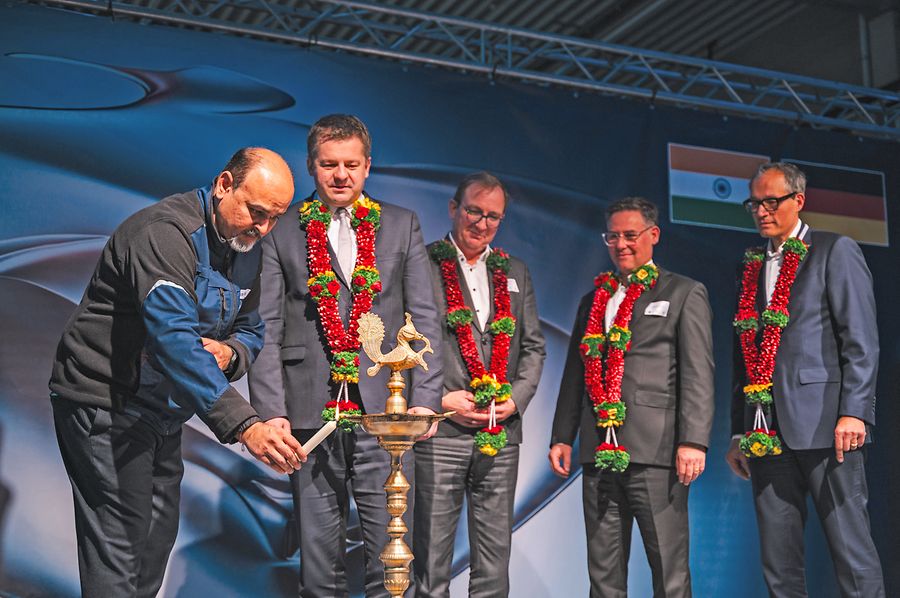
LMG Manufacturing, the specialist in aluminum die casting, inaugurated its new production facility in Hoym/Seeland after just ten months of construction. LMG is a subsidiary of Jaya Hind Industries based in Pune, India. The aluminum specialist manufactures lightweight components for vehicle manufacturers, including motor mounts, subframes, and housings for ancillary components used in internal combustion engines, hybrid vehicles, and pure electric cars. By establishing specialized processing technology combining aluminum die casting and plastic injection molding, LMG has created a new unique feature throughout Europe.
Prasan Firodia, owner and CEO of Jaya Hind Industries, states, "75 years of German-Indian partnership and the technical expertise of the parent company Jaya Hind Industries, with its strong vertical integration of technologies, lead LMG into a future of electromobility." The expansion of the site was dynamic, starting with the groundbreaking in March 2023, followed by the topping-out ceremony in May 2023. The official start of serial production coincides with the inauguration of the manufacturing hall. "Saxony-Anhalt is an attractive, sought-after location for settlements. We are not only experiencing large investments in chip industry but also in many other branches such as pharmaceutical, medical, and automotive industry. This underscores why Saxony-Anhalt has gained high international visibility," explains Dr. Robert Franke, Managing Director of the Investment and Marketing Corporation Saxony-Anhalt mbH.”

In September 2023, Daimler Truck officially laid the foundation for its largest logistics project in Halberstadt. Starting from 2025, the Global Parts Center in Halberstadt/Harz is set to deliver spare parts worldwide. Initially, around 450 jobs will be created, with an investment of nearly 500 million euros. The new logistics center will supply up to 300,000 different items – from the smallest screw to complete truck cabins – to nearly 3,000 dealerships in over 170 countries worldwide. Thus, the Global Parts Center plays a crucial role in ensuring international supply chains.
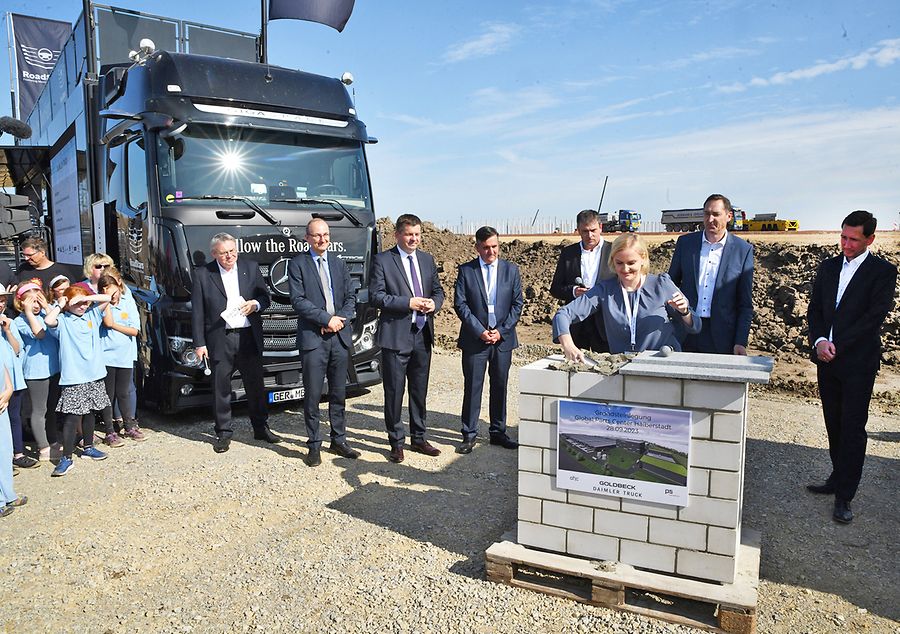
In the coming year alone, approximately 100 new employees will be hired, with 400 employees working in a two-shift system. The logistics facility is planned from the start to operate in a carbon-neutral manner, with the energy concept completely avoiding fossil fuels. No natural gas or oil will be required. The site's heating will be provided by electric heat pumps, distributing warmth through underfloor heating systems. Additionally, extensive photovoltaic panels on the roofs are planned to generate up to 13 million kWh of electrical energy per year, surpassing the site's consumption. The excess energy from the Global Parts Center will be supplied to other Daimler Truck locations in Germany. Green roofs will adorn the ancillary buildings. In the initial expansion phase, the new construction in the Industrial Park East of Halberstadt will cover an area of approximately 270,000 square meters, with around 260,000 square meters dedicated to logistics. Following further construction phases and assuming additional responsibilities in global parts logistics, up to 600 jobs may be created at the site in the future.
Sustainability Across the Entire Product Lifecycle
Production has already commenced at Nokera in Jerichower Land. With the Green-Construction-Factory in Stegelitz near Möckern, the world's largest factory for the production of residential buildings using serial timber construction has started operations. "The production halls are ready, we initiated the test operation in December, and by the end of May, production for the first houses will be fully operational," announced NOKERA founder Norbert Ketterer. With the Stegelitz factory, NOKERA aims to produce more than 20,000 apartments annually at four production sites in Germany in the coming years. A three-shift operation is planned for the site in the future, according to the founder.
An investment of 300 million euros has been made in the construction and equipment of the factory, totaling one billion euros in the project, according to the company. Additionally, a factory has been established in Erfurt, Thuringia, producing additional components for the houses. The wood for the houses comes mainly from German forests, confirms Ketterer, with about 20 percent sourced from Scandinavian countries. "It's no longer just about the operation of a building being carbon-neutral; production and later recycling must also be. And in these aspects, we are leading with our construction method," the founder proudly reports.
Li-Cycle Holdings Corp. (NYSE: LICY), a global leader in the recovery of lithium-ion battery resources, celebrated the opening of its first European Spoke Recycling Facility in Sülzetal near Magdeburg in Saxony-Anhalt in 2023. It stands as one of Europe's largest recycling facilities for lithium-ion batteries.
Equipped with Li-Cycle's patented and environmentally friendly "Generation 3" Spoke Technology, Germany Spoke has the capability to process all types of lithium-ion battery waste, including complete batteries from electric vehicles, without the need for prior discharge, disassembly, or thermal treatment. Each mainline boasts a processing capacity of up to 10,000 tons of lithium-ion battery material per year. With a planned additional capacity of 10,000 tons, the facility is expected to provide a total processing capacity of 30,000 tons per year. The central location near key battery manufacturing sites and Li-Cycle's customers, supportive industrial policies, and backing from local interest groups and communities make Sülzetal an ideal location for the Spoke Facility. Germany is also the largest market for waste from battery production and used batteries from lithium-ion batteries in Europe. Germany Spoke currently employs around 60 staff and will further enhance the region's significance in the environmental technology industry.
Richard Storrie, President EMEA at Li-Cycle, adds, "The state of Saxony-Anhalt is the ideal location for our first European recycling facility, and we are pleased to celebrate this milestone together with representatives from the region. Our first Spoke facility in Europe supports our growing customer base in Germany, the continent's largest battery market. We will collaborate with the people of Saxony-Anhalt for a clean energy future."
With a symbolic groundbreaking ceremony, WIPAG Deutschland GmbH, a specialist in the material processing of technical plastic waste, initiated the construction of a new production hall in Gardelegen. The medium-sized company uses innovative recycling technologies to process plastic waste streams, reintroducing them as valuable materials into the products of processing industries. Also part of WIPAG's sustainable portfolio is the lightweight compound WIC, made from secondary carbon fiber. Founded in 1991, the company operates with over 100 employees across three locations in Germany and has been part of the globally active, family-owned Otto Krahn Group since 2018.
The new facility focuses on the development of recycling technologies and the production of plastic compounds, including those based on recycled carbon fibers. The new production building for the manufacture of high-quality carbon fiber-reinforced plastics is being constructed on a 39,000 square meter site. The Otto Krahn Group is investing a total of 10 million euros at the Gardelegen location. The construction of the new production facility is expected to be completed by spring 2024, with the capacity to produce over 3,000 tons of high-quality carbon fiber compounds annually starting from 2024. The reused carbon fibers significantly reduce the carbon footprint of the lightweight and highly durable plastics produced with them.
Economic Factor Tourism
In 2023, the Rotkäppchen Experience World in Freyburg (Unstrut) unveiled its doors, presenting a modern visitor highlight centered around Germany's most beloved sparkling wine brand. For over 160 years, the sound of popping corks has echoed in Freyburg (Unstrut) as Rotkäppchen has maintained its status as the country's leading sparkling wine brand. Since May 2023, the newly opened Experience World invites visitors on a fascinating journey through the company's history, providing impressive insights into the production process and numerous opportunities for hands-on participation. To create this experience, two floors in the cellar facilities of the historic sparkling wine cellar were extensively renovated. Additionally, a new building on the outdoor premises houses the reception, bar, and shop of the Rotkäppchen Experience World, with the pavilion's architecture inspired by the Gründerzeit era.
"Trying, discovering, and actively participating is the motto in the Experience World. Germany's leading sparkling wine brand is now accessible in a new and interactive way. We are delighted to share this milestone with our brand enthusiasts and guests," says Christof Queisser, CEO of Rotkäppchen-Mumm, adding, "Freyburg is the heart and home of Rotkäppchen. The Rotkäppchen Experience World creates a benefit for the region, city, brand, and location." In 2022, the company achieved a total revenue of 1.2 billion euros across its nine locations.
Outlook on the Largest Federal Construction Project of the Decade
Looking ahead to future economic and civic development, significant progress has been made in Saxony-Anhalt in 2023. The city of Halle (Saale) has been awarded the contract for the establishment of the Future Center of German Unity and European Transformation. With an investment of 200 million euros from the federal government, this project stands as its largest construction endeavor of the decade. The Future Center is scheduled to be erected by 2029 on the central Riebeckplatz, a symbol of change itself. It aims to stimulate interest in questions related to German unity and provide a platform for dialogue to enhance mutual understanding. The center is designed to bring together people from across Germany and Europe, fostering mutual learning and understanding. Leveraging experiences from past transformations, it seeks to address upcoming challenges, with a focus on culture, dialogue, and research.
Halle (Saale) emerged victorious against six other East German cities in securing this project. The jury highlighted the city's excellent infrastructure and its status as a prominent scientific hub, home to institutions such as the National Academy of Sciences Leopoldina and the Weinberg Campus, where thousands of scientists explore solutions for the future. Halle (Saale) is simultaneously an intriguing site of transformation, requiring constant rethinking over the years. An example of this is the successful transition in the chemical region. The impending shift in the lignite coal region marks the next significant transformation process. The Future Center aims to contribute the experiences of the 30-year transformation in East Germany to the entire country. These experiences are intended to inform the tackling of new challenges such as digitization.
